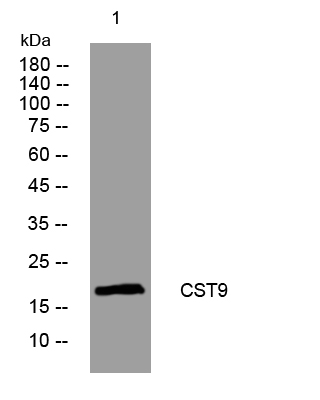- Home
- About
- Promotions
-
Products
-
Elisa Kits
- |
-
Primary antibodies
- |
-
Secondary antibodies
- |
-
Proteins
- |
-
IHC reagents
- |
-
WB reagents
- PonceauS Staining Solution
- PBST Washing Buffer, 10X
- 1.5M Tris-HCl Buffer, pH8.8
- 1M Tris-HCl Buffer, pH6.8
- 10% SDS Solution
- Prestained Protein Marker
- TBST Washing Buffer, 10X
- SDS PAGE Loading Buffer, 5X
- Stripping Buffered Solution
- Tris Buffer, pH7.4, 10X
- Total Protein Extraction Kit
- Running Buffer, 10X
- Transfer Buffer, 10X
- 30% Acr-Bis(29:1) Solution
- Tris电泳液速溶颗粒
- PBS(1X, premixed powder)
- TBS(1X, premixed powder)
- 快速封闭液
- 转膜液速溶颗粒
- Chemical reagents
- News
- Distributor
- Resources
- Contact
- Home
- >
- Info
- >
- CST9 rabbit pAb
- >
- Go Back
CST9 rabbit pAb
- Catalog No.:YT7586
- Applications:WB
- Reactivity:Human;Mouse
- Immunogen:
- Synthesized peptide derived from human CST9 AA range: 108-158
- Specificity:
- This antibody detects endogenous levels of CST9 at Human/Mouse
- Formulation:
- Liquid in PBS containing 50% glycerol, 0.5% BSA and 0.02% sodium azide.
- Source:
- Polyclonal, Rabbit,IgG
- Purification:
- The antibody was affinity-purified from rabbit antiserum by affinity-chromatography using epitope-specific immunogen.
- Storage Stability:
- -15°C to -25°C/1 year(Do not lower than -25°C)
- Molecular Weight(Da):
- 17kD
- Background:
- The cystatin superfamily encompasses proteins that contain multiple cystatin-like sequences. Some of the members are active cysteine protease inhibitors, while others have lost or perhaps never acquired this inhibitory activity. There are three inhibitory families in the superfamily, including the type 1 cystatins (stefins), type 2 cystatins and the kininogens. The type 2 cystatin proteins are a class of cysteine proteinase inhibitors found in a variety of human fluids and secretions, where they appear to provide protective functions. The cystatin locus on chromosome 20 contains the majority of the type 2 cystatin genes and pseudogenes. This gene is located in the cystatin locus and encodes a secreted protein that may play a role in hematopoietic differentiation or inflammation. [provided by RefSeq, Jul 2008],
- Function:
- function:May play a role in hematopoietic differentiation or inflammation.,induction:Up-regulated by LPS, in some cancer cells such as promyelocytic leukemia cells (HL-60) or myelomonocytic leukemia cells (U-937).,similarity:Belongs to the cystatin family.,subcellular location:May be targeted through the Golgi via the secretory pathway.,tissue specificity:Expressed in heart, placenta, lung, liver, skeletal muscle and pancreas. Not expressed in brain. Barely expressed in tumor cell lines except for breast adenocarcinoma MCF-7 cells and U251 cells.,
- Subcellular Location:
- Secreted . May be targeted through the Golgi via the secretory pathway. .
- Expression:
- Expressed in heart, placenta, lung, liver, skeletal muscle and pancreas (PubMed:12535658). Not expressed in brain (PubMed:12535658). Expressed in epididymis, kidney, testis, spinal cord, and thymus with a strong expression in epididymis and kidney and a weak expression in the spinal cord and thymus (PubMed:20565543).

- Western blot analysis of lysates from U2OS cells, primary antibody was diluted at 1:1000, 4°over night




